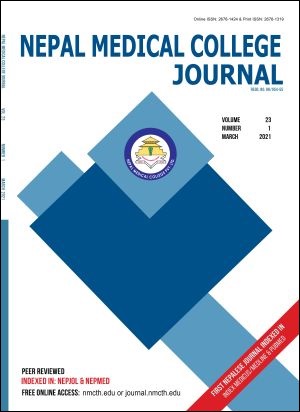Subcutaneous Fat Thickness and the Risk of Superficial Incisional Surgical Site Infection Following Open Appendectomy
DOI:
https://doi.org/10.3126/nmcj.v23i1.36218Keywords:
Appendicitis, incisional, obesity, risk factors, SCFT, SSIAbstract
Obesity is a known risk factor for surgical site infection (SSI). Recent studies have demonstrated that fat burden at the incisional site rather than body mass index (BMI) is a more precise and sensitive measure to predict the risk of SSI. The purpose of the study was to evaluate the correlation between subcutaneous fat thickness (SCFT) at the level of Mc Burney’s point and the occurrence of superficial incisional SSI among the patients undergoing open appendectomy. A total of 120 patients who underwent open appendectomy were included in the study. SCFT was measured preoperatively with ultrasonography (USG). The occurrence of superficial incisional SSI was evaluated in relation to SCFT. Previously identified well established risk factors for the development of SSI were also considered by the study. Statistical analysis was performed using SPSS version 17. Overall, superficial incisional SSI was observed in 27 (22.5%) participants. Mean SCFT at the level of Mc Burney’s point among male and female population was 2.26 cm ± 0.74 (SD) and 2.02 cm ± 0.83 (SD) respectively. Patients with superficial incisional SSI had a mean fat thickness of 2.80 cm and those without SSI had mean fat thickness of 1.97 cm. The difference in SCFT was statistically significant (p=.001). More interestingly, the area under the ROC curve was more for SCFT, in comparison to BMI among the patients who developed superficial incisional SSI (81% vs. 73%). Furthermore, we analysed the occurrence of superficial incisional SSI with SCFT cut off at 2.80 cm, which was statistically significant. As majority of the study population were young adults, risk factors like smoking, diabetes mellitus and nutritional status failed to demonstrate significant correlation with post appendectomy wound site complications. The study demonstrated that the thickness of subcutaneous fat at the site of inci sion is a good predictor of superficial incisional SSI following open appendectomy and the risk of superficial wound site infection increases as the thickness of subcutaneous fat at the site of incision increases.
Downloads
Downloads
Published
How to Cite
Issue
Section
License
This license enables reusers to distribute, remix, adapt, and build upon the material in any medium or format, so long as attribution is given to the creator. The license allows for commercial use.




